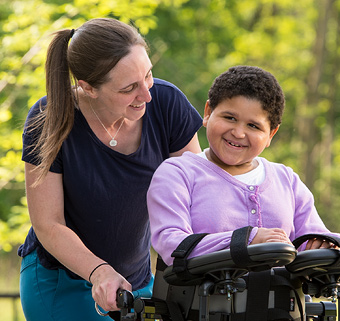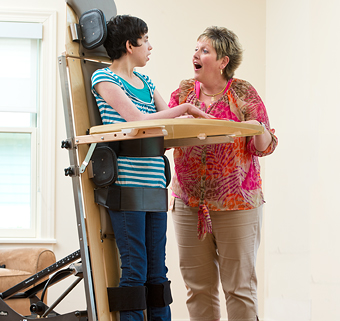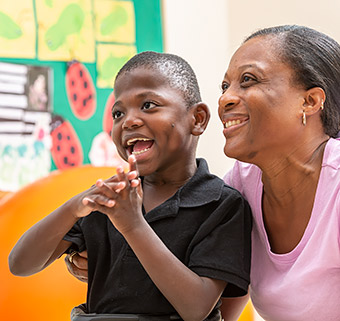Funding Pediatric Adaptive Equipment and the Role of Developmental Planning
| August 2011 Obtaining funding for pediatric adaptive equipment can be challenging. But how you document a child’s needs, can significantly improve your chances of success. Using a developmental planning approach that encompasses both current and future adaptive equipment needs can make all the difference.
Obtaining funding for pediatric adaptive equipment can be challenging. But how you document a child’s needs, can significantly improve your chances of success. Using a developmental planning approach that encompasses both current and future adaptive equipment needs can make all the difference.
Planning for physical needs, cognitive needs and equipment
Developmental planning is the process of using developmental milestones to guide the plan of care for children from birth to age three. The goal is to help children achieve developmental milestones using adapted or alternative means at the same age as they occur with typical development.
However, developmental planning is not only a framework for planning care, but also a way to plan for funding and resources. Although adaptive equipment can only be funded for current needs, an equipment plan tied to future developmental milestones provides a solid foundation and “paper trail” to support future requests. This kind of big-picture documentation can make the medical review process far more fruitful. Too often, only current mobility deficit is addressed.
Developmental planning and the Letter of Medical Necessity
As you document medical necessity for pediatric adaptive equipment, consider not only a child’s current needs, but also those five years down the road. What are the current functional deficits? How does this relate to cognition? What are the upcoming developmental milestones? Will they be achieved within the acknowledged critical time frame without adaptive equipment intervention?
The medical reviewer will more readily provide funding for devices that are specifically tied to functional activities, cognition and recognizable time frames.
For example: consider a nine month-old with spastic quadriplegic cerebral palsy. He presents with significant sensory and motor deficits approximating a GMFCS score of three. You predict that without some adapted intervention, the child’s independent sitting, pre-gait and standing are likely to be accomplished outside of acknowledged critical time frames, which may negatively impact his cognition and other areas of concurrent development.
Planning with the child’s family might begin by discussing equipment to address the current deficits, such as a positioning chair using a commercial feeder seat. The next three milestones ‒rolling, crawling, and pre-gait ‒ would then require adaptive equipment such as a prone pillow or wedge and eventually a stander.
Similarly, this kind of timeline should be included in documentation of medical necessity for equipment, demonstrating how you plan to address deficits and minimize developmental delays going forward. The letter of medical necessity might include information such as:
- Your initial assessment of the child, including the predictive scale GMFCS score and your assessment of his cognition and specific concurrent goals.
- Description of a trial period with an adaptive seating device and outcomes, such as the effects on spatial awareness, tone and head control, interaction level and cognition.
- Discussion of how the positioning wedge will contribute to developing head control/graded head movements.
- Discussion of other ongoing assessments for a stander, gait trainer, and wheeled mobility solutions.
With this holistic information, the medical reviewer will be aware of anticipated adaptive equipment needs and interventions and their role in the child’s overall development. It will also allow you to reference your previous letters of medical necessity when asking for additional equipment. Reviewers do look at this information and it helps to present a solid case for equipment funding.
Conclusion
Using a developmental planning approach that integrates developmental milestones and cognition provides strong support for funding adaptive medical equipment. It acknowledges foundational learning, concurrent development, and the relevance of cognition. And it emphasizes alternative means rather than alternative time frames. This approach generates the best documentation for the pediatric client who will require different types of equipment and interventions over time.
Figure 1
| Adapted Item | When considered | Notes |
| Positioning Chair | 7-9 Months | Can be trialed with alternate materials like a commercial feeder seat or tri-wall |
| Positioning Wedge | 7-9 Months | Prone or side-lying options can be trialed with boppy, towels or pillows |
| Stander | 9-11 Months | Swaddling the trunk and lower extremities snugly and position in standing couch side for support is a good innocuous way to start the trial. Trial of specific devices a must for family buy in, serious funding consideration and improved accuracy of recommendations. |
| Bath Seat | 20-35 pounds | Timeframe varies greatly with family resources |
| Car Seat | 20 pounds | This weight is minimum weight of most available adapted car seats. |
| Gait Trainer | 11-13 months | Trial of specific devices a must for family buy in, serious funding consideration and improved accuracy of recommendations. |
| Mobility Device | 13-24 months | Review and include research on cognition and mobility when considering a mobility device. Begin with articles on www.GinnyPaleg.com |
For help with letters of medical necessity for medical equipment go to www.lmnbuilder.com or you can email me directly at jnoland@pi-med.com




